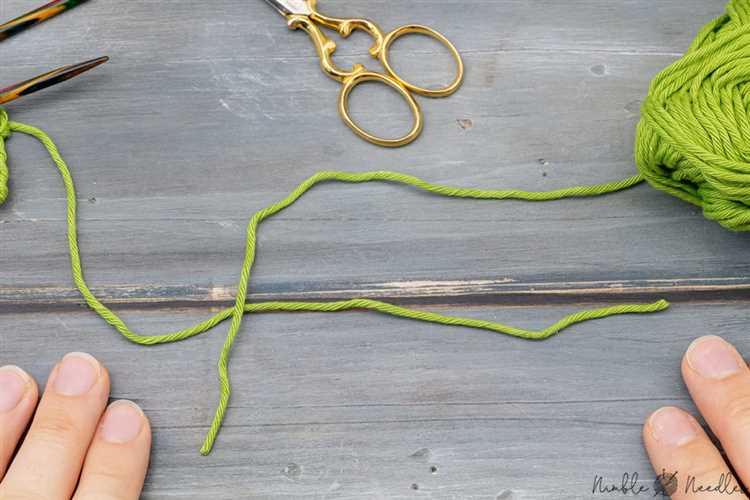When knitting a large project, it’s common to run out of yarn before you’re finished. Adding a new ball of yarn is a simple and essential skill for any knitter to master. Not only does it allow you to continue working without interruption, but it also ensures that your finished project has a seamless and professional look.
Before adding a new ball of yarn, it’s important to assess the best place to make the join. Look for a section of your knitting where the join will be inconspicuous, such as in the middle of a row or in a place where the yarn tail can be easily woven in later.
To add a new ball of yarn, start by selecting a yarn that matches the color and weight of your current project. Cut a long tail, approximately 6-8 inches, to ensure you have enough to weave in later. Thread the tail onto a yarn needle, and then insert it through the stitches on your knitting needle, making sure to leave a small loop.
Next, take your new ball of yarn and leave a tail of approximately 6-8 inches. Hold the new yarn tail along with the old yarn tail, and then start knitting with the new yarn. Work several stitches with both yarns held together to create a secure join. Once you’re confident that the join is secure, you can drop the old yarn and continue knitting with the new ball.
When you’ve finished knitting with the new ball of yarn, it’s time to weave in the ends. Thread the yarn tail onto a yarn needle and carefully weave it through the stitches on the wrong side of your project, following the path of the knitting. Make sure to weave in the tail for at least 1-2 inches to ensure that it won’t come undone.
Note: When adding a new ball of yarn, it’s always a good idea to alternate skeins if you’re using more than one. This helps to blend any variations in dye lots and ensures a more even color throughout your project.
By following these simple steps, you can easily add a new ball of yarn to your knitting without any noticeable joins or interruptions. Now you can confidently tackle large knitting projects without worrying about running out of yarn!
Step 1: Gather the Necessary Materials
Before you start adding a new ball of yarn to your knitting project, it is important to gather all the necessary materials. Having everything prepared beforehand will make the process much smoother. Here’s what you’ll need:
- Knitting needles: Make sure you have the appropriate size needles for your project.
- Yarn: You’ll need the new ball of yarn that you want to add to your project. Choose a yarn that matches or complements the color and weight of the existing yarn.
- Tapestry needle: This needle will be used to weave in the ends of the yarn later on.
- Scissors: You’ll need a pair of scissors to cut the old yarn and the new yarn.
- Stitch marker (optional): If you are working with a pattern that requires you to keep track of your stitches, a stitch marker will be helpful.
Having these materials at hand will save you from interruptions while you are working on your knitting project. It’s always better to be prepared!
Step 2: Find the End of the Old Ball of Yarn
First, locate the end of the old ball of yarn that you have been using for your knitting project. This end is usually hanging loose from the last stitch you made.
If you are having trouble finding the end, gently tug on the loose yarn from the working end of your project until you see the end of the yarn coming out.
Once you have found the end of the yarn, make sure it is free from any tangles or knots that may hinder your knitting progress. This will ensure a smooth transition when joining the new ball of yarn.
It is also a good idea to leave a tail of about 6-8 inches at the end of the old ball of yarn. This extra length will provide you with enough yarn to weave in the loose end later, ensuring a secure and tidy finish to your project.
Step 3: Attach the New Ball of Yarn
Once you have reached the end of your current ball of yarn, you will need to attach a new ball in order to continue knitting.
- Prepare the new ball of yarn: Before attaching the new ball, make sure you have prepared it by winding it into a ball or skein. This will make it easier to work with.
- Identify the end of the new ball of yarn: Look for the end of the yarn in the new ball. It is usually tucked inside the center or wrapped around the outside of the ball.
- Hold the old and new yarns together: Take the end of the old yarn and hold it together with the end of the new yarn.
- Tie a small knot: Tie a small knot using the two ends of yarn. Make sure the knot is tight enough to secure the yarn but not too tight that it causes the knitting to bunch up.
- Continue knitting: Once the yarn is securely attached, you can continue knitting with the new ball.
Alternatively, if you prefer not to tie a knot, you can also join the new ball of yarn by overlapping the ends and knitting a few stitches with both yarns held together. After a few stitches, you can drop the old yarn and continue knitting with the new yarn only.
Remember to weave in the loose ends of the old and new yarns when you finish your project to tidy up any remaining loose ends.
Step 4: Secure the Yarn with a Knot
After joining the new ball of yarn to your project, you’ll want to secure it with a knot to prevent it from unraveling.
Here’s how to secure the yarn with a knot:
- Take the two yarn ends—the end of the previous ball of yarn and the beginning of the new ball of yarn—and overlap them by a few inches.
- Tie a double knot by creating a loop with the two ends and pulling them through.
- Ensure that the knot is tight enough to hold the yarn securely, but not so tight that it distorts your stitches.
- Trim the excess yarn tails, leaving about half an inch of yarn beyond the knot.
Alternatively, if you prefer a more seamless look, you can weave in the ends of the yarn. This involves using a yarn needle to thread the yarn tails through the stitches of your project. This method is especially useful for projects that have more delicate or open stitches.
Remember, it’s important to secure the yarn properly to ensure that your project stays intact. If the knot comes undone while you’re knitting, it can lead to dropped stitches or unraveling of your work.
Now that your new ball of yarn is securely attached, you can continue knitting your project with confidence!
Step 5: Continue Knitting
Once you have added the new ball of yarn, you can continue knitting the rest of your project. Here are the steps to follow:
- Take the new end of yarn and hold it alongside the working yarn.
- Make sure the working yarn has enough slack to continue knitting comfortably.
- Insert the right needle into the next stitch on the left needle, as you normally would.
- With the right needle, wrap the new yarn over the right needle from back to front.
- Use the right needle to pull the new yarn loop through the stitch on the left needle, just like you would with the working yarn.
- Drop the old yarn and continue knitting with the new yarn.
- Make sure to keep a consistent tension with the new yarn to ensure an even stitch.
- Continue knitting the remaining stitches until you reach the end of the row or complete your desired number of rows.
Remember to take your time and be patient when adding a new ball of yarn to your knitting project. Practice makes perfect, and with time, you’ll become more confident in adding new yarn and creating seamless knitting stitches.
Step 6: Weave in the Loose Ends
After adding a new ball of yarn to your knitting project, it’s important to secure and hide the loose ends to give your finished piece a clean and professional look. Here’s how to weave in the loose ends:
- Thread the loose end onto a yarn needle: Take the loose end of the yarn and thread it onto a blunt-tip yarn needle.
- Weave the needle through the stitches: Insert the needle into the fabric of your knitted piece, following the path of the stitches. Weave the needle back and forth, making sure to secure the loose end without distorting the fabric.
- Trim any excess: Once the loose end is securely woven in, use a pair of scissors to trim any excess yarn, leaving a tail of about 1-2 inches.
It’s important to ensure that the loose ends are woven in securely to prevent them from unraveling over time. You can also weave in the loose ends as you go by knitting over them every few stitches, which can save you time and effort when finishing your project.
Step 7: Repeat as Needed
Once you have joined the new ball of yarn, you may need to repeat the process of adding a new ball of yarn multiple times throughout your knitting project. This will depend on the size of your project and how much yarn you have available.
If you run out of yarn while knitting, follow the same steps outlined in the previous sections to join a new ball of yarn. Make sure to leave a long enough tail when joining the new yarn so that you can weave in the ends later.
If you are knitting a large project that requires multiple balls of yarn, you may want to plan ahead and change yarns at specific points in your pattern, such as at the start of a new row or when changing colors. This can help ensure that your yarn joins are neat and tidy.
Remember to always secure your yarn joins by weaving in the ends with a yarn needle once you have finished your project. This will prevent your knitting from unraveling and help to give your project a more finished look.
By repeating these steps as needed, you can add new balls of yarn to your knitting project and create beautiful finished pieces that are as long as you desire!
Step 8: Finish your Project
To complete your knitting project and secure the stitches, you will need to finish off the project. Follow these steps to finish your project:
- First, you will need to bind off the stitches. To do this, knit the first two stitches of the row.
- Next, use your left needle to lift the first stitch over the second stitch and off the right needle.
- Continue to knit one stitch and lift the previous stitch over until you have one stitch remaining.
- Cut the yarn, leaving a 6-inch tail.
- Thread the tail through the last stitch, and pull it tight to secure the final stitch.
Once you have secured the final stitch, you can trim any excess yarn tails, leaving about an inch to weave in later.
If you are making a garment or a larger project, you may need to sew in any loose ends to ensure the project is sturdy and won’t unravel. To do this, use a yarn needle to weave the ends into the back of the work, following the stitches to hide the yarn tails.
Congratulations! You have successfully finished your knitting project. Enjoy your new creation or give it as a thoughtful gift.
FAQ:
What is the purpose of adding a new ball of yarn when knitting?
The purpose of adding a new ball of yarn when knitting is to continue the project when the current ball of yarn is about to run out.
At what point should I add a new ball of yarn?
You should add a new ball of yarn when you see that the current ball is nearly finished, usually when there is only a few yards left.
What do I need to do before adding a new ball of yarn?
Before adding a new ball of yarn, you should finish off the previous ball by completing the current row and then cutting the yarn, leaving a tail of about 6 inches.
How do I add the new ball of yarn?
To add the new ball of yarn, you will start by making a slip knot with the new yarn, then insert the needle into the next stitch and begin knitting with the new yarn as usual.
Can I add a new ball of yarn in the middle of a row?
Yes, you can add a new ball of yarn in the middle of a row. To do this, you will need to secure the tail of the old yarn by knitting it together with the new yarn for a few stitches.
How do I secure the tails of the old and new yarns?
To secure the tails of the old and new yarns, you can weave them in later using a yarn needle. This helps to prevent unraveling and gives a neater finish to your knitting.
What should I do if I make a mistake when adding a new ball of yarn?
If you make a mistake when adding a new ball of yarn, you can simply unravel the stitches back to the point where you made the mistake and try again. It’s a common and easily fixable mistake.


